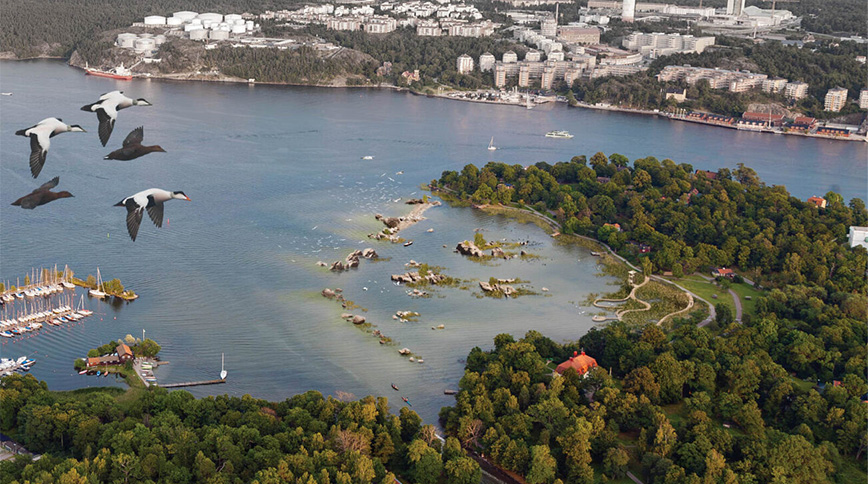Stone from the new metro enriches Stockholm's waters

Soon, Stockholm's predatory fish will have a sanctuary, parts of Stockholm's shoreline will be shielded against erosion, and the city's residents will get a new place for recreation. This results from a joint initiative by the City of Stockholm and Gaia arkitektur, in which KTH researcher in landscape urbanism, Ania Öst has been involved from the start. The Massa project turns the problem of vast amounts of rubble from the ongoing metro expansion into an opportunity - if actions are taken in time.
Metro constructions generate a significant amount of stone. When the Stockholm metro was expanded in the mid-20th century, the excess stone was used for the creation of hills like Högdalstoppen, Hökarängstoppen, and eight other peaks around the city. However, there was no vision for the use of the stone in the current expansion, and the expectation was that there would be a demand for purposes such as road construction. At the time, a decade ago, the idea was also to use trucks to transport the stone through the city.
Funding from Formas to transform a problem into a resource
This was recognised by Luc Pagès of the City of Stockholm, Marta Bohlmark of Gaia arkitektur, and Ania Öst, a researcher at KTH's department of architecture, who also works as an architect at Gaia arkitektur. With the City of Stockholm and Gaia arkitektur as co-applicants, KTH received funding from Formas to explore how the masses of stone could be used to create new habitats in Stockholm's inner archipelago.
“In the plans for the expansion of the new metro, it was included that the stone would be transported away by thousands of trucks on Strandvägen”, says Ania Öst. “Already then, there was an expectation of an annual surplus of millions of tons of stone beyond market needs.”
During the project, the City of Stockholm has developed new collaborations across organisational boundaries, leading to a facility at Loudden to handle the masses, enabling the replacement of tens of thousands of truck transports with barge traffic. The project has also gained new knowledge, including tests on leaching that will provide insights into the properties of the stone and how it can be used. The project group has studied similar projects in Denmark and Norway to learn from their experiences. Another tangible result is that Stockholm's perspective has shifted; when the new metro line between Älvsjö and Fridhemsplan is built, the 2.6 million tons of stone are considered a local resource from the start.
Five prototypes ready for Stockholm's shores
Several concrete ideas from the Massa project have come closer to becoming a reality. Five prototypes have been developed to use stone to reduce wave action and create favourable environments for animals, plants, and people. The prototype that has come farthest involves creating an artificial reef and islands to form a lagoon at Isbladsviken near Djurgården. It is intended to serve as a wave breaker to counteract shoreline erosion caused by passing boats and create a 6.5-hectare area suitable for pike, perch, plants, and birds. Currently, a process is underway to gather feedback on the project.
“If everything goes according to plan, the Isbladslagunen could begin construction in 2025”, says Ania Öst. “The concept is scalable and can be used in many other locations. What I find fantastic about these prototypes is that the construction is just the beginning of the process. We can observe how plants and animals establish themselves and the site develops over many years. This is different to the normal case where the project is finished when the construction is complete.”
A visible change for the better
There are challenges and problems as well. Some are very concrete, such as washing the stone from nitrogen-rich explosive residues before use, to avoid eutrophication. Others involve gaining acceptance for the fact that Stockholm, like other cities, is growinga and evolving.
“Studying old maps of Stockholm, you can see that the city's shoreline has constantly changed. Our prototypes would also mean a visible change, and it would be a positive change for nature and the people in Stockholm in familiar places like Riddarholmen, Rålambshovsparken, Skeppsholmen, and Årsta holmar. It's about increased biodiversity, more fish, cleaner stormwater, and more beach life.”
Regardless, getting hold of enough stone is not one of the problems. The demand may even diminish in today's economic situation, and the surplus consecuentely grow. However, it is crucial to take advantage of the temporal window we are in.
“Many problems can be addressed with the help of the rubble, but there hasn't been a coordinated vision”, concludes Ania Öst. “Hopefully, Massa and subsequent projects can contribute to seizing this enormous opportunity now that we have the chance and ultimately create a better city.”
